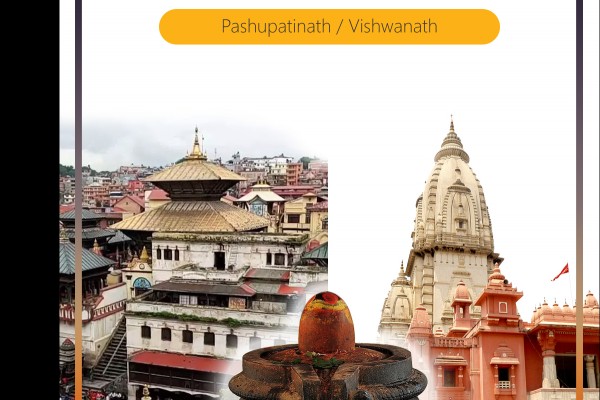The Spiritual Link Between Pashupatinath and Kashi Vishwanath Temple

“Just as a candle cannot burn without fire, men cannot live without a spiritual life." This famous quote by Lord Buddha centuries ago is still very much prevalent today. When it comes to finding inner peace and reaching the spiritual nirvana, men have gone far and wide find the link between themselves and the almighty.
It is said that only when our senses are turned inward, from the material to the spiritual, we align with the Divine and become fulfilled. Such fulfillment can be found through religion. One of the strongest spiritualities in Hindu religion in terms of geography is found between Nepal and India.

The historical and cultural ties between India and Nepal date back centuries, but when it comes to spiritual link, Varanasi holds the key. No other city in India has closer spiritual ties to Nepal than this holy city on the banks of Ganges. Varanasi retains its identity as a centre for religious pilgrimage for many reasons, and one of the biggest reason is the link between Kashi Vishwanath and Pashupatinath.
Standing on the western bank of the holy River Ganga is Kashi Vishwanath Temple which is considered as one of the twelve Jyotirlingas; the holiest of Shiva Temples. The temple has been referred to Hindu scriptures for a long time as a central part of worship in the Shaiva philosophy.
The significance of Kashi Viswanath Temple and Pashupatinath Temple is interlinked especially in relation to Hindu faith. Situated on the banks of the Bagmati River, north-east of Kathmandu Valley, Pashupatinath Temple is considered to be the "शिर" meaning head of Lord Shiva, while Kashi Viswanath Temple is considered to be the "धड" meaning the headless body. Thus, the true vision of the divine Lord Shiva is considered incomplete without worshipping both temples.
Furthermore, according to holy scriptures, there are four "Prasidha Dhams" located in all four cardinal directions i.e. Rameshwar Temple in the south, Dwarkadhish Temple in the west, Badrinath Temple in the north and Jagnath Temple in the east, which are all located in India. Hindu devotees take long journeys to visit all four "Prasidha Dhams." However, their journey to spiritual liberation is incomplete without visiting Kashi Vishwanath Temple and Pashupatinath Temple.
Apart from the link to the four "Dhams" they also share common practices when it comes to showing devotion to Lord Shiva, especially the shirangar aarti. Shringar aarti is the beautification process where the deity is grandly decorated with colorful clothes and jewelry before being revealed to devotees. The Shirangar aarti and is performed at both Kashi Vishwanath Temple and Pashupatinath Temple as a sign of love, respect and devotion to Lord Shiva.
At Pashupatinath Temple, the shringar aarti is performed once daily as it is the "शिर" of Lord Shiva and at Kashi Vishwanath Temple, it is performed 4 times a day. This aarti is considered to be one of the grandest and most beautiful forms of worship which should be witnessed at least once in your lifetime.
Similarities can be further found in the form of another deity, "Shitala Mata." There is a well known saying in Sanskrit which goes like this, कुपुत्रो जायेत क्वचिदपि कुमाता न भवती ।
Shitala Mata is the epiphany of this saying - there can be a Kuputra (fallen disobedient son turning away from Mother), but there can never be Kumata (Mother turning away from son permanently). A replica of her can be at the entry point of Pashupatinath Temple and a life-size version of her can be found at Kashi Vishwanath Temple.
The link between the two temples is believed to be so strong that the "jal" found in both temples act as a substitute for each other as they have been prepared using the same rituals. Every Nepali must visit Kashi Vishwanath Temple at least once in their life as the rivers that flow from the Himalayas of Nepal eventually flows to Kashi. A visit to Kashi is considered to equivalent to a visit of all the rivers of Nepal.
All commonalities forge a golden rule, "A visit to holy Kashi Vishwanath Temple is forever incomplete without a visit to Pashupatinath Temple and vice versa."
